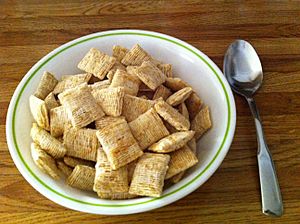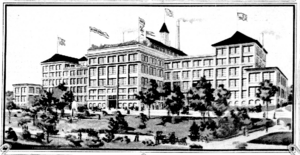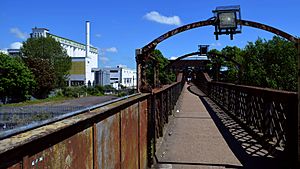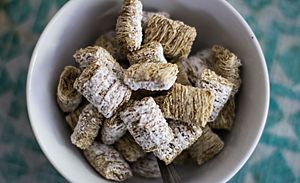Shredded wheat facts for kids
 |
|
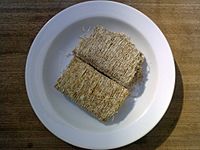
Original size
|
|
| Owner |
|
|---|---|
| Introduced | 1893 |
| Previous owners | Cereal Machine Company |
Shredded Wheat is a popular breakfast cereal made from whole wheat. It comes in pillow-shaped biscuits. You can find it in three main sizes: the original large size, a smaller "bite-sized" version, and an even tinier "miniature" size.
The smaller sizes often come in a frosted variety. This means one side is covered with sugar and sometimes gelatin. Some companies also make "filled" versions. These might have a raisin, apricot, blueberry, or other sweet filling inside.
In the United States, Post Consumer Brands is a major seller of Shredded Wheat. They bought the product in 1993 from Nabisco. Kellogg's also sells many kinds of miniature shredded wheat cereal. In the United Kingdom, the Shredded Wheat brand belongs to Cereal Partners, a company linked to Nestlé. Shredded Wheat was first made in the U.S. in 1893. Production in the UK started later, in 1926.
Contents
How Shredded Wheat Began
In the United States and Canada
A man named Henry Perky invented shredded wheat cereal in Denver, Colorado, in 1890. He also started a company called "Cereal Machine Company." In 1895, Perky got a patent for his invention. The cereal biscuits became more popular than the machines he sold. So, Perky opened bakeries in Boston and Worcester, Massachusetts.
Perky got the idea for shredded wheat after seeing someone mix wheat with cream. He figured out a way to process wheat into long strips. These strips were then shaped into the pillow-like biscuits we know today.
To make the cereal, wheat is first cooked in water until it's soft. Then, it's "tempered," which means the moisture spreads evenly through the grain. Next, the wheat goes through rollers with grooves. This creates webs of shredded wheat strands. Many of these webs are stacked together. This moist stack is then pressed to make individual cereal pieces. Finally, these pieces are baked in an oven until they are dry and crispy.
Perky first sold his cereal to vegetarian restaurants in 1892. His factory was in Niagara Falls, New York. A health magazine even suggested using shredded wheat biscuits as croutons in soup.
Dr. John Harvey Kellogg, who later co-founded the Kellogg Company, liked Perky's way of making cereal. However, he thought Shredded Wheat tasted "like eating a whisk broom." Later, after seeing how successful Perky's cereal was, Kellogg offered to buy the patent. But Perky thought the price was too low.
Shredded Wheat was first shown to the public at the Chicago World's Columbian Exposition in 1893. The Natural Food Company started making it in Niagara Falls, New York, in 1901. This company became the Shredded Wheat Company in 1904. Later, in 1928, Nabisco bought the company.
In 1954, Shredded Wheat production in the U.S. moved to Naperville, Illinois, where it is still made today. In 1993, Nabisco sold the brand to Kraft Foods.
In Canada, Shredded Wheat has been made in Niagara Falls, Ontario, since 1904. This location was chosen because of the nearby hydro-electric power.
Henry Perky's son, Scott Henry Perky, created a round shredded wheat cereal called Muffets in 1920. The Muffets Corporation was sold to the Quaker Oats Company in 1927. Muffets are still sold in Canada. In the U.S., they are now known as Quaker Shredded Wheat.
In the United Kingdom
UK History
The original company opened a factory in Welwyn Garden City, Hertfordshire, UK, in 1926. This factory later became part of Nabisco in 1928. The tall concrete cereal silos at the factory are a well-known local landmark.
In 1988, Nabisco sold its UK business to Rank Hovis McDougall. Then, in 1990, Cereal Partners bought the site. Now, all Shredded Wheat in the UK is made at Staverton, Wiltshire. The Welwyn Garden City factory closed in 2008. In the UK, you can also find "Bitesize," "Fruitful," and "Honey Nut" Shredded Wheat.
Famous Advertising
Shredded Wheat is famous in the UK for its long-running TV ads. In the 1970s, there was a campaign with a song that started:
- "There are two men in my life,
- To one I am a mother,
- To the other I'm a wife,
- And I give them both the best
- With natural Shredded Wheat"
Later, the "Three Shredded Wheat" campaign became very popular. These ads suggested that the cereal was so filling, it was impossible to eat three biscuits! One ad even showed a black hole exploding when it tried to eat a third biscuit. Phrases like "I bet you can't eat three" became common jokes. Famous people like Brian Clough and Ian Botham appeared in ads, pretending they couldn't eat three.
The "Shredded Wheat" Name
After Henry Perky passed away in 1906, his patent for Shredded Wheat ended in 1912. John Harvey Kellogg saw this as a chance for Kellogg's to sell its own version. Kellogg got a new patent for the biscuit in 1915, and Kellogg's Shredded Wheat was created.
This made Nabisco (the National Biscuit Company) sue Kellogg's. Nabisco wanted to stop Kellogg's from using the name "Shredded Wheat" and from making the cereal in the same pillow shape. This legal fight went all the way to the Supreme Court of the United States in 1938.
The Supreme Court decided that "shredded wheat" was a general term, like "bread" or "milk." This meant no one company could own the name as a trademark. They also ruled that when the first patent for the cereal-making machines ended in 1912, the right to use the name "shredded wheat" became free for everyone to use.
Eating Shredded Wheat
Shredded wheat is made entirely from whole wheat. Two biscuits (about 47 grams) have 160 calories. They contain 1 gram of fat and 6 grams of dietary fiber. This means they are a good source of fiber!


